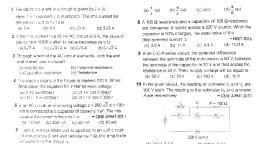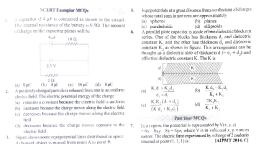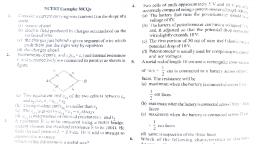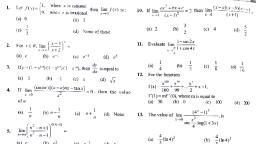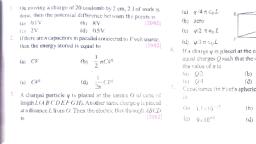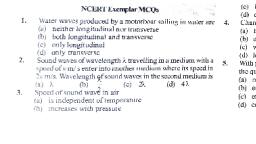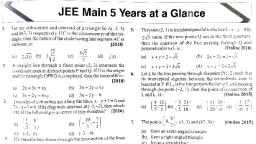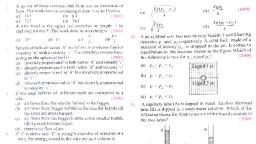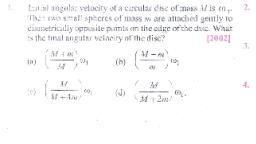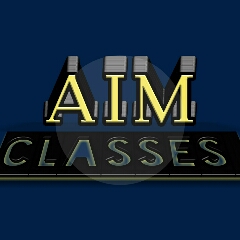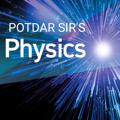Question 1 :
The wavelength of the short radiowaves, micro waves, ultraviolet waves are ${ \lambda }_{ 1 }, { \lambda }_{ 2 }$ and ${ \lambda }_{ 3 }$ respectively. Arrange them in decreasing order.
Question 2 :
A wave has wavelength $50A^o$. State the speed of wave in vacuum.<br/>
Question 3 :
Name the rays or waves produced by the changes in the nucleus of an atom.<br/>
Question 4 :
Assertion: The phenomenon of $X-$ ray production is basically inverse of photoelectric effect.
Reason: $X-$ are electromagnetic waves.
Question 5 :
In electromagnetic spectrum, the frequencies of $\gamma$-rays, X- rays and ultraviolet rays are denoted by $n_1, n_2$ and $n_3$ respectively then.<br/>
Question 6 :
The count rate of a Geiger-Muller counter for the radiation of radioactive material of half life of 30 minutes decreases to 5 s<sup>-1</sup> after 2 hours. The initial count rate was -
Question 7 :
μ-meson is a particle which has charge same as that of the electron and mass 207 times the mass of electron. A μ-mesonic atom is formed when a μ-meason is captured by proton. The ionization energy of such an atom is-
Question 8 :
Consider the nuclear reaction X<sup>200</sup>→ A <sup>110</sup> + B<sup>80</sup>. If the binding energy per nucleon for X, A and B are 7.4 MeV, 8.2 MeV and 8.1 MeV respectively, then the energy released in the reaction -
Question 9 :
Two alpha-particles with equal energies are fired towards the nucleus of a gold atom. Which diagram could represent their paths (in the plane of the paper)?<br><img style='object-fit:contain' src='https://storage.googleapis.com/teachmint/question_assets/JEE%20Main/5e788432135d6370e9dc19ab' height='209' width='325' >
Question 10 :
<sub>86</sub>A<sup>222</sup>→<sub>84</sub>B<sup>210</sup>. In this reaction how many α and β particles are emitted -
Question 12 :
Thermionic emission from a heated flament varies with its temperature {tex} T {/tex} as
Question 14 :
In the grid circuit of a triode a signal {tex} E = 2 \sqrt { 2 } \cos \omega t {/tex} is applied. If {tex} \mu = 14 {/tex} and {tex} r = 10\ { k } \Omega {/tex} then root mean square current flowing through {tex} R _ { L } = 12\ { k\Omega } {/tex} will be
Question 15 :
The difference in the variation of resistance with temperature in a metal and a semiconductor arises essentially due to the difference in the
Question 16 :
When 100 volts dc is supplied across a solenoid, a current of 1.0 amperes flows in it. When 100 volts ac is applied across the same coil, the current drops to 0.5 ampere. If the frequency of ac source is {tex} 50 \mathrm { Hz } {/tex}, then the impedance and inductance of the solenoid are
Question 17 :
An ac source of angular frequency {tex} \omega {/tex} is fed across a resistor {tex} r {/tex} and a capacitor {tex} C {/tex} in series. The current registered is {tex} l {/tex}. If now the frequency of source is changed to {tex} \omega / 3 {/tex} (but maintaining the same voltage), the current in then circuit is found to be halved. Calculate the ratio of reactance to resistance at the original frequency {tex} \omega {/tex}
Question 18 :
In an oscillating {tex} L C {/tex} circuit the maximum charge on the capacitor is {tex} Q {/tex}. The charge on the capacitor when the energy is stored equally between the electric and magnetic field is
Question 19 :
{tex}\mathbf {Assertion}{/tex} : An inductance and a resistance are connected in series with an ac circuit. In this circuit the current and the potential difference across the resistance lag behind potential difference across the inductance by an angle {tex} \pi / 2 {/tex}. <br>{tex}\mathbf {Reason}{/tex} : {tex} \ln L R {/tex} circuit voltage leads the current by phase angle which depends on the value of inductance and resistance both.
Question 20 :
The reading of ammeter in the circuit shown will be<br><img style='object-fit:contain' src="https://storage.googleapis.com/teachmint/question_assets/JEE%20Main/5db7f532bc98b123bb8398b0"><br>

